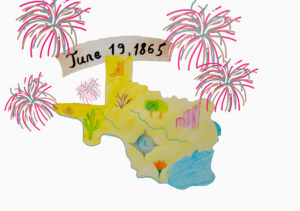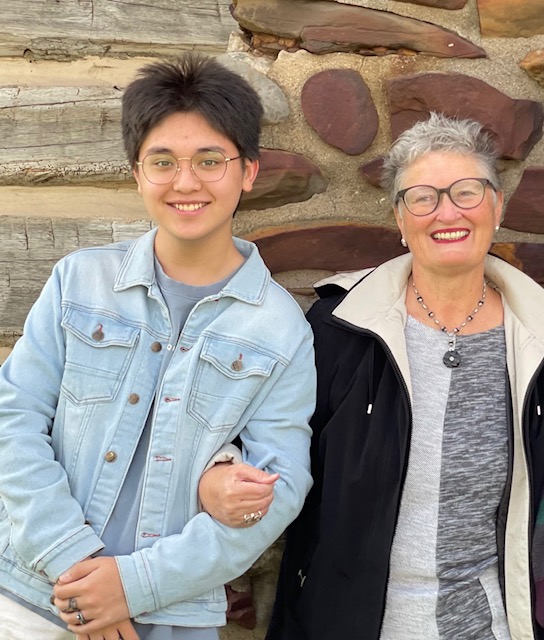Juneteenth
Nance Legins-Costley
First Slave Freed by Abraham Lincoln
Rich Illinois History Preserved by International Youth
Written by Aleeya Taufik from Malaysia
Illustrated by Assyl Bakytov from Kazakhstan
For the series A BOOK by ME - True Stories Written by Kids for Kids
 I retired last year after more than two decades working with exchange students from developing countries. They come to the U.S.A. on scholarships and spend a school year with a host family and attend the public high school. My job as local coordinator included giving them educational enhancements. In the spring semester of 2022, we studied the Underground Railroad and learned about Nance, a brilliant girl who was enslaved in Illinois (ironically a free state). Through a series of events, she was set free in a court battle by a young attorney named Abraham Lincoln. This was more than twenty years before his famous Emancipation Proclamation.
I retired last year after more than two decades working with exchange students from developing countries. They come to the U.S.A. on scholarships and spend a school year with a host family and attend the public high school. My job as local coordinator included giving them educational enhancements. In the spring semester of 2022, we studied the Underground Railroad and learned about Nance, a brilliant girl who was enslaved in Illinois (ironically a free state). Through a series of events, she was set free in a court battle by a young attorney named Abraham Lincoln. This was more than twenty years before his famous Emancipation Proclamation.
When Nance was freed, her children were too. Her infant son William Costley grew up and served in the Civil War in an all black regiment. On June 19, William Costley and his regiment were sent into Galveston, General Gordon Granger announced, “The people of Texas are informed that, in accordance with a proclamation from the executive of the United States, all slaves are free.” A celebration followed, one that continues each year on what is known as Juneteenth.
An exchange student named Aleeya Taufik from Malaysia wrote this story and a young man named Assyl Bakytov from Kazakhstan brought the story to life with his art. – Deb Bowen, A BOOK by ME
“I came here as an exchange student from Malaysia in January of 2022. After I arrived I learned from our Local Coordinator that my exchange group, mostly who arrived in the fall, had been learning about those who helped on the Underground Railroad. I heard there was an opportunity to tell an important story for young readers, and I said yes before I really understood what abolitionists were.
Then a speaker, Professor Owen Muelder, came to share with us, and I learned a lot with his help. Abolitionists were simply those willing to risk a penalty and help runaway slaves escape. The Underground Railroad didn’t have train tracks; it was a system based on people who were abolitionists.”
– Author Aleeya Taufik
- Author at Lincoln’s Tomb in Springfield
- Artist with Deb Bowen, A BOOK by ME
 Nance Legins-Costley
Nance Legins-Costley
Freed From Bondage by Abraham Lincoln
The powerful story of Nance Legins-Costley is not well known. Her story is more subtle than those of high-profile abolitionist leaders. Her courage was amazing. Barely a teenager, she stood up for her civil rights in a court of law that was stacked against blacks. She was seeking freedom, the most basic of human rights.
Despite anti-slavery laws, the territory and state of Illinois permitted a system of indentured servitude. The length of servitude varied but could extend as long as 99 years. The law implied the need for consent by the servant, but the system was just slavery by another name.
Nance was born in 1813 in Kaskaskia, which was the state of Illinois’ first capital. She was the daughter of Randall and Anachy Legins, who had been bought as indentured servants by Colonel Tom Cox for $770. By laws of the time, Nance could be held or sold as an indentured servant until age 28. In 1820, Nance was seven years old, and her sister Dice was five years old. They were working at Cox’s Columbia Hotel. Though the state capital already had moved to Vandalia, businessmen and other travelers would stay there and discuss issues of the day, including slavery. Although Nance had no schooling, she was bright and often listened intently to conversations.
The Cox family moved to Springfield in 1822. This city was in the center of the state of Illinois and would become the official capital in 1839. By 1827, Colonel Tom Cox had a drinking problem and was deep in debt. A court ordered the sale of all of his possessions, including his indentured servants. The sale, which was held in 1827, was the only legal slave auction in Illinois’ history. Young Dice was sold for $150 to a man named Taylor, while Nance was sold for a dollar more to Nathan Cromwell. Dice went quietly, but Nance did not want to leave the only family she had ever had, so she resisted going with Cromwell. She showed a remarkable amount of gumption for a black girl who was not even 14 years old!
Cromwell took Nance from Springfield to his home in Sangamo Town. There, he put her in solitary confinement by locking her in a windowless salt house for a week. He didn’t know that young Nance was not done fighting. Despite the court-ordered sale of his property, Colonel Cox was filing petitions to keep his possessions, including his indentured servants. During a court hearing, Nance testified that she had given no consent for the sale of any contract: “It is not true that I, Nance, voluntarily and of my own free will, agreed to go with Cromwell to his house in Sangamo Town, nor is it true I still live with Cromwell by choice.”
The case went to the Illinois Supreme Court, where justices ignored Nance’s plea and ruled against Cox. Her consent made no difference, as the sale had been legal. Cox kept up the fight with repeated appeals regarding Nance and the court-forced sale. In 1829, Cromwell and his wife, Ann Eliza, took Nance when they moved to Tazewell County, where they helped found a new city. Mrs. Cromwell gave Pekin its name. She died a few years later, and Nathan Cromwell decided to move to Texas, hoping to strike it rich.
Twenty-three-year-old Nance objected to the move. Cromwell didn’t want to cause a scandal, traveling with a single black woman with a baby and another on the way. He approached a merchant named David Bailey to suggest Nance stay behind and work at his store. Bailey agreed to this arrangement, since he was an abolitionist. He believed that by helping Nance he would be taking a step toward breaking her indentured servitude. Bailey owed Cromwell $400, so the offer to take Nance was also intended to cancel the debt.
Bailey agreed, but only if Cromwell could produce the papers for her indentured servitude. The deal was made, but Cromwell left for Texas without providing Nance’s paperwork. He arrived in St. Louis, Missouri, where he unexpectedly died. When Nance learned of his death, she declared herself free and left Bailey’s service.
On October 15, 1840, she married a free black man named Benjamin Costley. In addition to her two daughters, Amanda and Eliza Jane, the household would include a son in 1841: William Henry Costley.
But still, Nance wasn’t free in the eyes of the law. Next, a relative of Cromwell sued for Bailey’s $400 in cash. Bailey felt he owed no money since the sale had been nullified by the lack of the agreed-upon indentured servitude documents. When a judge disagreed and deemed Nance a possession, Bailey took the case to the Illinois Supreme Court in Springfield. For legal help, he contacted an attorney friend with whom he had served in the Black Hawk War. The man was Abraham Lincoln, who was 32 years old and serving his fourth term in the State Legislature. At the time, Lincoln had mixed feelings on slavery. He was wary of extreme abolitionists, as some would burn flags, which he felt had never gone over well with veterans and patriotic Americans. Mr. Lincoln did not want to be seen as an anarchist.
 In principle, Lincoln opposed slavery, and he wanted to help his friend. He saw merit in the case, especially as it related to Nance’s long fight for freedom. Nance and Lincoln discussed matters of the case, which helped solidify his ideas about slavery. Lincoln appeared before the state’s high court on July 9, 1841.
In principle, Lincoln opposed slavery, and he wanted to help his friend. He saw merit in the case, especially as it related to Nance’s long fight for freedom. Nance and Lincoln discussed matters of the case, which helped solidify his ideas about slavery. Lincoln appeared before the state’s high court on July 9, 1841.
His arguments leaned heavily on anti-slavery and justices agreed; they ruled in favor of Bailey and Lincoln: “It is a presumption of law, in the State of Illinois, that every person is free, without regard to color. The sale of a free person is illegal.” This victory came long before Abraham Lincoln became the nation’s president and more than 20 years before the Emancipation Proclamation. Nance became the first black person freed from bondage by Lincoln, and she was followed by approximately four million other slaves who were eventually freed.
When Nance was set free, so were her children. Her infant son, William Costley, was the first male freed from bondage by Abraham Lincoln. Nance and her husband remained in Pekin and had five more children. Nance made sure all of them attended school. They lived in a log cabin along the Illinois River. Even before the high court’s ruling, she had become a valued community member.
Nance’s son, William Costley, served at the forefront of the Civil war, another key event in the fight for racial equality. Young William left Pekin in 1864 to join the 29th Illinois Regiment of U.S. Colored Troops, the largest regiment and the only Black regiment from Illinois. After many battles they were sent to Texas in June 1865. Although General Robert E. Lee had surrendered on April 9, Union troops never had invaded Texas, leaving 250,000 slaves there.
On June 19, with Costley and his regiment among troops sent into Galveston, General Gordon Granger announced, “The people of Texas are informed that, in accordance with a proclamation from the executive of the United States, all slaves are free.” A celebration followed, one that continues each year on what is known as Juneteenth.
After the war, William Costley returned to Pekin. There, in 1870, he was at the center of another racially connected court case. On a Pekin Street, a convicted rapist was brutally assaulting a woman. When the white man refused his demand to stop the attack, Costley shot him dead. Though charged with murder, Costley was acquitted by an all-white jury, which called his actions “justifiable homicide by protecting a woman in need.”
William moved to Minnesota in the 1880s. His father Ben died in 1883. William suffered greatly with shoulder pain from a shrapnel injury incurred during the war. He was admitted to Rochester State Hospital and died there in 1888. His beloved mother Nance died in Peoria at age 79 on April 6, 1892.
Nance Legins-Costley: First Slave Freed by Abraham Lincoln
Written by Aleeya Taufik from Malaysia
Illustrated by Assyl Bakytov from Kazakhstan
A BOOK by ME, a book series developed by Deb Bowen, empowers students to preserve history by telling the story of unsung heroes in our communities. For the young participants, it’s a guided cross-curricular project that gathers stories of people who do amazing things but have received little or no recognition. Students learn how to publish a picture book that is a primary source document with photographs and a biography.
Since 2003, Deb Bowen has been arranging meetings between students and individuals from the WWII generation. This intergenerational storytelling results in unique storybooks written and illustrated by kids for kids in the A BOOK by ME series. More about Deb Bowen >






